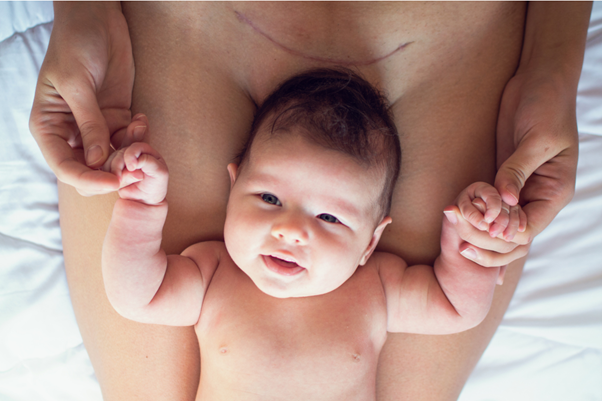
Congratulations on your new arrival! The early postpartum time can be an overwhelming period of changes and challenges and that can include concerns about recovery after c-section. If you gave birth through a caesarean section (C-section), you may be facing additional challenges as you navigate the physical demands of recovery after c-section including your c-section scar healing well.
Giving birth through C-section is a major abdominal surgery that requires a longer recovery period than a vaginal birth. This blog is aimed to give you information on ways to optimize your recovery after c-section safely and effectively and enjoy this special time with your baby.
During the first 4 weeks after childbirth, it is important you take time to rest in a comfortable horizontal position as this helps with your recovery by helping reduce swelling and pain.
*Speak to your health provider on advice to your particular situation
It is important to move with care to reduce the strain on the stitches of the abdominal wound after a c-section.
Getting back to bed: Sit on the bed, lower yourself onto the side using your arms and gently lift your legs back onto the bed as you move.
Once you feel comfortable to have support over your wound dressing, use of support wear such as SRC Recovery Shorts or Leggings can assist your recovery after c-section by providing compression around your abdominals and pelvis, which promotes blood flow to the scar site for healing.
Consider scar massage at various stages after your surgery to assist your recovery process. Scar massage can also help to improve blood circulation, reduce pain, and improve the overall appearance of the scar. The aim of scar massage after a C-section is to reduce adhesions and scar tissue, promote healing, and desensitize the incision area. An example of what that can look like is as follows: massage to the skin by applying a moderate amount of pressure over and around your scar. Aim for a few minutes daily once your incision has fully closed and you have had it checked by your GP or obstetrician.
All women including those that have had a c-section are encouraged to exercise their pelvic floor muscles and deep abdominal muscles. During pregnancy, these muscles can become weakened or stretched, which can lead to issues such as lower back pain and pelvic floor dysfunction. Even if you do not have symptoms.
Pelvic floor exercises provide many benefits and will help with the following:
Start with gentle pelvic floor exercises a few times a day after birth in lying and sitting. You should be able to feel the muscles tighten and also let go when you relax fully. Gradually increase your repetitions and hold time as you progress throughout the weeks.
These muscles, also known as the transverse abdominis, play a crucial role in providing stability and support to your lower back, pelvis, and abdomen. Gradual exercises of these muscles help to safely rebuild strength in your deep tummy muscles to support the healing process and prevent future complications. By strengthening these muscles, you can improve your overall core stability, reduce the risk of future injuries, and even improve your posture and body mechanics.
Adding stretches such as pelvic tilts, cat/camel, and back rotation can also promote joint flexibility and tone.
Walking is also an excellent low-impact exercise to start with.
It is important to have maintain healthy bladder and bowel habits in your c-section recovery.
Supporting your abdominal wall during a bowel movement can also help.
Seeing a women’s health physiotherapist following a c-section delivery can offer a holistic and individualized treatment plan that can include any of the following:
Written by Gaaya Manohararajan. Gaaya is a musculoskeletal and women’s health physiotherapist at Inner Active Pelvic Health Physiotherapy, a practice that solely focuses on women’s health and pelvic health rehabilitation services helping to restore confidence and strength in women after pregnancy and childbirth.
DISCLAIMER This is general information only. For specific advice about your healthcare needs, you should seek advice from your health professional. Inner Active Pelvic Health and Physiotherapy does not accept any responsibility for loss or damage arising from your reliance on this blog, see a qualified a health professional.
References:
| Item | Price | Qty | Total | |
|---|---|---|---|---|
| Subtotal |
$0.00 |
|||
| Shipping | ||||
| Total | ||||